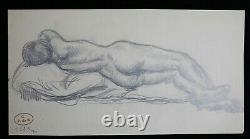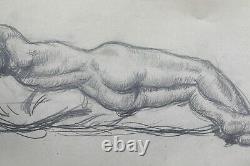
- Homepage
- Era
- Gender
- Material
- Metal
- Sub-type
- Type
- Aquarelle (34)
- Dessin (135)
- Drawing (84)
- Eau Forte (16)
- Engraving (37)
- Figurine, Statue (97)
- Gouache (33)
- Gravure (258)
- Huile (189)
- Lampe De Table (35)
- Lithograph (15)
- Lithographie (44)
- Montre Bracelet (70)
- Oil (40)
- Pendule à Poser (17)
- Sanguine (34)
- Sculpture (632)
- Statue Sculpture (63)
- Statue, Sculpture (240)
- Watercolor (15)
- Other (1452)
Georges Préveraud De Sonneville (1889-1978) Naked Woman Art Deco Gradignan Lhote






Drawing representing a female nude. Artist's hide at the bottom left.
Georges préveraud de sonneville came from a family of wine traders specializing in exporting products from Bordeaux to the new caledonia. Born on 1 March 1889 in Noumea, where his parents had settled, it was at the age of 14 that he arrived on bordeaux, already endowed with a solid draughtsman's training, acquired during childhood in Australia and in new caledonia, with English teachers.Presenting the antin paul workshop, one of the best known of Bordeaux artists of the time. He met his future wife, Yvonne latapi-tronquet, a painter, whom he married in 1914. He continued his artistic training in Paris, at the Ranson Academy where he attended the courses of maurice denis and paul serusier, bound with edouard goerg and andré lhote. Back in bordeaux, he became one of the animators of Bordeaux artistic life in the 1920s.
In 1919, he organized an exhibition in which Parisian and Bordeaux artists of avabt-garde were gathered "a group of modern painters", among them his friend andré lhote. After being initially fascinated by cubistic experiences, sonneville turned away from the nascent abstraction and cultivated a personal style, or the search for the rendering of emotions was paramount. For him, the concern for form must be secondary, otherwise the painter is lost in a simple decorator approach. Cultivating and transmitting sensations, creating poetry by means of color constitute for him the very essence of the profession of painter.During the war, then during the crazy years, he asserted himself as a recognized artist, present in the salons and celebrated by numerous personal exhibitions. The 1929 crisis forced him to practise an administrative profession, but he continued to paint, to draw under the name of sono in newspapers and to expose him to both burgundy and bets, where he settled from 1924 to 1964. His paintings tell about the harbours and their boats, the colourful landscapes of the Basque country, agricultural work and village scenes. He transfigures his subjects using a highly contrasting palette, and a powerful expressiveness in the rendering of volumes. He died in 1978 in the town of Talence, in a gironde, where he had settled for twenty-four years.
A museum is dedicated to its work in the town of Gradignan. Drawing of a female nude. Artist's stamp lower left. Georges preveraud de sonneville comes from a family of wine merchants specializing in the export of products from the bordeaux vineyard to new cauldonia. Born march 1, 1889 in noumea, where his parents had settled, it was at the age of 14 that he arrived in bordeaux, already endowed with a solid training as a designer, acquired during his childhood in australia.
And in new padedonia, with english teachers. Entering the studio of paul antin, one of the best known bordeaux artists of the time. There he met his future wife, yvonne latapi-tronquet, also a paint, whom he married in 1914. He continued his artistic training in paris, at the academy ranson where he followed the races of maurice denis and paul serusier, binds himself with edouard goerg and andré lhote. Back in bordeaux, he became one of the animators of bordeaux artistic life in the twentieths. In 1919 he organized an exhibition trunging together avant-garde parisian and bordeaux artists "a group of modern artists", including his friend andré lhote. After initially being fascinated by cubist experiences, sonneville turned away from nascent abstraction and cultivated a personal style, where the search for the rendering of emotions was essential.For Him, the concern for form must be secondary, otherwise the painter gets lost in the process of a simple decorator. Cultivating and transmitting sensations, creating poetry by means of color, constitute for Him the very essence of the profession of painter.
During the war, there during the roaring twentiethies, he asserted hisself as a recognized artist, present in salons and celebrated through numerical personal exhibitions. The crisis of 1929 forced Him to exercise an administrative profession but he continued to paint, to draw under the name of sono in the newspapers and to exhibit both in bordeaux and in paris, where he settled from 1924 to 1964. His works canvases tell of the ports and their boats, the colorful landscapes of the Basque country, agricultural work and village scenes. He transfigures his subjects by using a palette of strong contrasting colors, and a powerful expressiveness in the rendering of volumes.
He said in 1978 in the town of talence, in gironde, where he had settled for twenty-four years. A museum is dedicated to his work in the city of gradinan. This item is in the category "art, antiques\art of xixe and before\designs, lavis". The seller is "fineantik" and is located in this country: fr.

